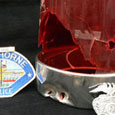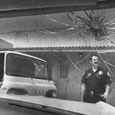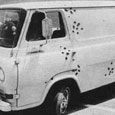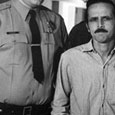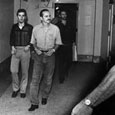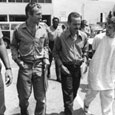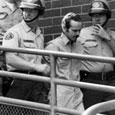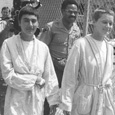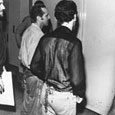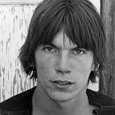Author Archives: cielodrive.com
Manson & Parole
Sunday, April 8th, 2012
With Charles Manson’s 12th and possibly his last parole hearing just days away, we take a look back at his 33 years of parole eligibility.
Media Coverage
Corcoran, Calif. – The California board of prison terms will hold a parole hearing for Charles Manson in Corcoran State Prison Wednesday. The parole hearing will be Manson’s 12th, even though he’s only attended 6 of his prior 11.
Manson, who is now 77 years old, has skipped his last two hearings, with his last appearance to one 15 years ago.
Manson was convicted and sentenced to death in 1971 for orchestrating the murder spree that claimed 9 lives, including the 8 1/2 months pregnant actress Sharon Tate.
The following year, the California supreme court outlawed the death penalty, claiming it cruel and unusual punishment. Charlie’s sentence was commuted to life imprisonment, making him eligible for parole in 1978.
HEARING No. 1 • THURSDAY, NOVEMBER 16, 1978
His first parole hearing was held on Thursday, November 16th, 1978 at the California Medical Facilty in Vacaville. During the three hour hearing, Manson continued to deny ordering the murders. “If I wanted anyone killed. I’d kill them myself. But I don’t want anyone killed because I love my own life,” Manson told the three member panel.
When asked about his plans if paroled, Manson said, “My plan would be to go to the wilderness and live off the land. I’d go to the desert and talk to the animals. I couldn’t make it running by the watch and making that car payment. My ways are simple.”
After the recess the board chairman returned the decision, telling Manson “You are not suitable for parole.”
“I agree,” said Manson, “I’m totally unsuitable for that world out there. I don’t fit in at all.”
HEARING No. 2 • TUESDAY, NOVEMBER 27, 1979
Manson refused to attend his second hearing held on Tuesday, November 27th, 1979. Instead he had a prison guard deliver a 7 page handwritten letter, $200 in monopoly money and a CHANCE card that read, “Advance to Go, Collect $200.”
In the letter, Manson stated, “I break no law. I didn’t get my rights to start with. I talked to your board once and have been treated as a fool since then. The truth is you are a bunch of liars.”
According to his psychiatric report, Manson was described as a “schizophrenic in remission with sporadic psychotic episodes.”
Although his discipline record indicated he had been found with bits of razor blades and metal in his cell, a prison spokesman said Charlie had “been really pretty mellow,” and spent most of his time weaving, writing letters, watching television, reading the newspaper and playing the guitar.
HEARING No. 3 • TUESDAY, NOVEMBER 4, 1980
Manson did attend his third hearing on Tuesday, November 4th, 1980. When the board made suggestions on how he could improve himself for his next hearing, Manson responded: “I’m not going to do that…I’ll stay here forever…I’ve got that long.”
HEARING No. 4 • WEDNESDAY, NOVEMBER 4, 1981
For his fourth hearing in November of 1981, Charlie came dressed in a skull and crossed bones t-shirt. During the 4 hour hearing, Manson’s attorney, Glen DeRonde argued not for Charlie’s parole, but for his release from solitary confinement.
“I’m not ready for parole,” Manson told the board. “I could have saved you all this time.”
Manson, who played with 2 large marbles in his hand throughout the hearing, told the board he expected to spend the rest of his life in jail.
“By the time I get out, I’ll parole to space,” said Manson.
The three-member board, headed by Chairman Robert Roos, unanimously declared Manson unsuitable for parole.
HEARING No. 5 • WEDNESDAY, DECEMBER 2, 1982
Manson refused to attend his fifth hearing, which was held on Wednesday, December 2nd, 1982. Deputy District Attorney Stephen Kay told the board, “Charles Manson believes he can do anything he wants whenever he wants.”
“I’ve no doubt that if he (Manson) were let out he’d be leading other people to commit murders again,” said Kay.
Manson’s psychiatric report recommended Charlie be removed from the psych ward because he was just a “psychiatric curiosity or oddity.”
Up until this hearing, California law required any inmate serving a life sentence have a parole hearing each year. Changes to the law now gave the board the ability to deny parole for up to 3 years.
The panel took only 55-minutes to conclude that Manson was unsuitable for parole for the maximum 3 years.
HEARING No. 6 • TUESDAY, FEBRUARY 4, 1986
Charlie’s sixth hearing was held at San Quentin on Tuesday, February 4th, 1986. Prosecutor Stephen Kay cited a list of psychiatric reports of various mental illnesses dating back to Manson’s youth.
“You have recited a long list of misinformation, and I can’t respond to all of it,” Charlie said. “I’ve been playing doctors like pianos since 1950.”
Kay also spoke about Manson’s discipline record, listing off 42 infractions which included possession of hacksaw blades and spitting at guards.
Manson, with his long graying hair and beard arrived to the hearing with a 20 page document, which he read to the board. Abruptly leaving without waiting for the panel to return their decision. Parole denied for 3 years.
HEARING No. 7 • WEDNESDAY, FEBRUARY 8, 1989
Charlie’s seventh hearing held on Wednesday, February 8th, 1989, lasted about an hour. Manson refused to attend after the warden wouldn’t allow him to appear before the panel without his handcuffs and waist chain.
The parole board deliberated for 27 minutes before finding Charlie unsuitable for parole for another 3 years.
HEARING No. 8 • TUESDAY, APRIL 21, 1992
Manson was back in attendance for his eighth hearing held at Corcoran State Prison on Tuesday, April 21st, 1992. Manson indicated he was nervous and not used to people because of his long time in solitary confinement.
A review of his discipline record showed Manson had committed around 60 infractions dating back to his 1983 hearing.
When the panel asked Charlie if he had any remorse for the victims. Manson did not accept responsibility for the crimes, but stated:
“You say in your minds that I’m guilty of everything that you’ve got on paper. So therefore, it would run logic that I would need to have remorse for what you think is reality, and if that be true, then all the oceans’ contents, if it were my tears, there would not be enough to express the remorse that I have for the sadness of that world that you people live in.”
Deputy District Attorney Stephen Kay read from a board report that quoted Manson saying he had, “no plans for the future, that he was not interested in paroling and that he would be lost in our society.”
“Well, I can tell Mr. Manson that our society feels the same way about him,” responded Kay. “We don’t want him back.”
Two years earlier, California passed a law that increased the amount of years a parole board could deny an inmate. Changing the maximum denial from three to five years.
At the end of the two hour hearing, Manson was denied parole for five years.
HEARING No. 9 • THURSDAY, MARCH 17, 1997
Manson’s ninth parole hearing – the last one he’s attended to date – was held on Thursday, March 17th, 1997. The Gray haired, 62-year-old arrived wearing sunglasses.
When asked where he’d go if paroled, Manson replied he’d go “poof” with a grin on his face.
“I’ve killed a lot of people in my life,” said Manson. “I have. But I was convicted for things I didn’t do and I was let loose for things I did.”
The board denied him parole for 5 years, saying he was still too dangerous for society.
HEARING No. 10 • WEDNESDAY, APRIL 24, 2002
Charlie’s tenth hearing was held on Wednesday, April 24th, 2002. It was the first hearing for Manson that anyone from the Tate family attended.
“I would like to give him a piece of my mind,” said Debra Tate, Sharon’s younger sister.
Tate would not get the chance. Once again Charlie refused to attend because he didn’t want to be handcuffed.
A review of his prison record showed Manson had 17 “serious” infractions since his last parole hearing five years earlier.
The infractions included threatening staff and possession of a weapon.
Once again, Manson was denied the maximum 5 years.
HEARING No. 11 • WEDNESDAY, MAY 23, 2007
Manson’s most recent parole hearing was held at Corcoran on Wednesday, May 23th, 2007. It was Charlie’s first hearing without District Attorney Stephen Kay representing Los Angeles County. Kay had stepped down in 2004 and in his place was prosecutor Patrick Sequeira
Although Manson wasn’t in attendance the board reviewed his file. Charlie had added twelve more infractions since the 2002 hearing. He didn’t participate in any rehab programs or take a psychiatric evaluation.
The board denied Manson for 5 more years.
HEARING No. 12 • WEDNESDAY, APRIL 11, 2012
Prison officials have indicated that Manson has no intention of attending his upcoming parole hearing. He will instead send his lawyer to represent him.
Since becoming eligible for parole 33 years ago, Charles Manson has always been denied the maximum amount of years allowed by law.
Current law allows the board of prison terms to deny parole for up to 15 years.
Given his history of denials combined with his age, it is possible that Wednesday’s hearing will be Charlie’s last.
Tex Watson Denied Parole For 5 Years
Wednesday, November 16th, 2011
IONE, California, Nov. 16 – Charles “Tex” Watson, 65, has been denied parole for the 16th time, at a hearing Wednesday in Mule Creek State Prision in Ione, California.
Watson was convicted of seven counts of first degree murder and one count conspiracy to commit murder in October of 1971 for his part in the August 1969 Tate-Labianca killings, which included the 8 ½ months pregnant Sharon Tate.
Watson was also involved with the killing of Spahn Ranch hand Donald “Shorty” Shea, although he was never tried for the murder.
The parole hearing was also attended by relatives of the victims, including Jay Sebring’s nephew Anthony DiMaria, who reflected:
“We want to bring the memories of the victims into the room as the commissioners deliberate on whether to parole the inmate.”
Watson will not be eligible for parole until 2016.
The Hawthorne Shootout
Sunday, August 21st, 2011
1971
08/23/71
08/23/71
08/23/71
08/23/71
08/24/71
09/17/71
10/10/71
1972
06/30/72
1973
03.24.73
LOS ANGELES, Aug. 21 – It was a typical late-August Saturday night, just after 9pm. Officers Jim Matthews and Bob Siegel were in their cruiser patrolling the area of Imperial and Hawthorne Blvd. when the call came in. A 211 alarm(robbery) at the Western Surplus store on the corner of Hawthorne Blvd. and 134th Street. “The alarm at Western Surplus was a rare event, and they did not have ‘false alarms’, as many stores did, because they were very careful people,” said Siegel.
Blocks away at the Western Surplus store a clerk had trigger the silent alarm. Four men and a woman just came into the store with a sawed-off shotgun, ordering two customers and the three employees to lie down on the floor. The group immediately began smashing cases and bringing guns into the rear alley, where another woman is waiting in a white 1966 Ford van.
Officers Jim McInerny and Kenny Cox were the first officers to arrive at the scene, parking in front of the building. Both men, with guns drawn, exited their vehicle and took positions on either side of the front window of the store.
Lieutenant James Kobus pulled up in unit 55A. McInerny turns and asks Kobus to cover the back alley.
“I think I saw someone move inside,” Cox said.
McInerny turns around and sees a man duck behind a counter in the rear of the store. Seeing the officers outside, the suspects inside make their way towards the backdoor.
Officers Jim Matthews, Bob Siegel, and Kobus pull into the alley entrance as the suspects come out the back door.
“Officer Matthews drove around the corner and we saw Lt. Kobus as he pulled up from the south and stopped at the north curb line of 134th street, where he immediately came under shotgun fire from the rear of the store. Fortunately, as Watch Commander, he was alone in the unit, a station wagon because the first shotgun blast went through his right passenger windshield and would have hit a passenger officer full in the chest,” said Siegel.
The next blast from the shotgun puts a gaping hole in the emergency light atop of Kobus’ car.
Officers Cox and McInerny run west down 134th street toward the back alley. Cox begins firing back at the suspects’ van with his shotgun.
Officer McInerny gets behind a short wall that divides the alley and a residence on 134th street. As the van attempts to drive away, McInerny unloads his service revolver into the drivers side window. Out of bullets, a resident comes out of his apartment and supplies McInerny with more .38 ammo.
“We seemed to be getting fired on from within or below the van, so I ( and maybe Matthews and Cox) began firing to the rear of the driver door, and below the van, to bounce under the van at unseen suspects,” said Siegel.
“Gunfire ceased for a short spell, so I approached the drivers door to open it. Hearing another short burst of gunfire from with in the van I poked the barrel of my shotgun into the driver’s window, pointed to the rear side doors, and fire a single round of double ought buckshot, to clear the area,” said Siegel.
“Everybody get out of the vehicle,” shouts Matthews.
Officer Siegel opens the driver’s side door and the woman falls out. She has three gun shot wounds in her shoulder. She offers no resistance as she is handcuffed and whispers “I’m sorry.”
The officers hear activity in the back of the van. Matthews, Cox and Siegel go around the van and see several armed suspects fleeing on foot. The officers give chase.
“One male suspect had hidden under a car at the north end of the parking lot. He snuck out and was last seen running north in the alley, and then westbound on 133rd street. Several of us officers saw him, as did several citizen witnesses, but as we were in a firefight situation with four other suspects, no one was able to disengage to try to secure and identify this individual,” said Siegel.
After a few more shots are fired, the remaining suspects surrender and are taken into custody. By the time the fire fight is over about 30 officers from Hawthorne, El Segundo, Redondo Beach, and the Lennox Sheriff’s Station have responded to Kobus’ “Shots Fired” radio call. A LASO helicopter arrived after a short time and assisted in the search for the sixth suspect that escaped on foot.
In custody are, Jerry Sherwin, later identified as Mary Brunner, Catherine Share, Joseph Jones, later identified as Lawrence Edward Bailey, Dennis Rice, and Kenneth Como.
The sixth suspect is eventually identified as Charles Lovett is taken into custody.
No officers are injured but Brunner, Share and Jones all suffer wounds from buckshot pellets. Catherine Share – the driver – has a wounded shoulder; Brunner has an injured hand and Bailey has a shattered knee cap.
The alleged motive for the crime is to collect weapons so the group can raid the Gary Hinman-Donald “Shorty” Shea murder trial and free Manson.
Bail is set at $100,000 for each suspect. All suspects request to act as their own attorneys. Each requested is denied with the exception of Dennis Rice. On Thursday, June 29th 1972, Charles Lovett becomes the first to be convicted and is sentenced to 10 years-to-life for his participation in a robbery. Dennis Rice is next to be convicted in early 1973. He is sent to San Quentin for a sentence of 6 months to 20 years, but is released 2 years later. He has since become a Christian and runs a prison ministry traveling the globe telling his story to prisoners.
Catherine Share, Lawrence Bailey, Mary Brunner, and Kenneth Como go on trial together in 1973. Their jury is sequestered after 2 jurors are excused after receiving threatening phone calls. All four are convicted after an 8 day trial. All four claim they’re not guilty by reason of insanity. The defense calls Charles Manson to testify during the sanity phase. Manson testifies that all of them knew right from wrong and weren’t insane. All four are found to be sane at the time of the crime.
Catherine Share is sentenced to 10 years-to-life; Kenneth Como is sentenced to 15 years-to-life; Mary Brunner and Lawrence Bailey both receive sentences of 20 years-to-life.
Catherine Share is sent to the California Institute for Women in Frontera, where the other Manson girls are serving their sentences. There, Gypsy and Mary Brunner, together with a group of Aryan Brotherhood members, conspired to break out of the prison using a pair of wire cutters, but were caught at the last minute.
Gypsy had fell in love with Kenneth Como (also imprisoned for the Hawthorne shootout) but stopped talking to him after Manson told her not to. Como was in love with Gypsy, and obviously angered with Manson, so he assaulted Charlie in the prison yard. Soon after, Como convinced Gypsy to forget about Charlie, and the two got married; Gypsy eventually divorced Como in 1981.
In the late ’70′s, early 80′s, Gypsy was indicted and convicted on a range of Federal charges for her part in a credit card scam. She served a number of years, and somewhere down the line became a born-again Christian. She married a man named Patrick Shannahan, a prisoner turned informant.
Mary Brunner served six and a half years at the California Institute for Women, while her son Michael went to live with her parents. Mary has since took on an assumed name, and is last reported to be living in the Midwest.
Kenneth Como was released from prison in 1981. In January of 1984, Como was sentenced to 30 years in prison after pleading guilty to robbing a Glendora savings and loan office. Como was released in 2003 and passed away a year later.
